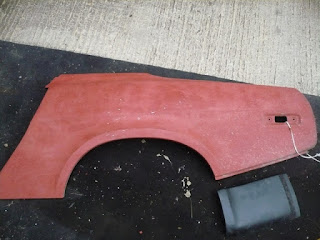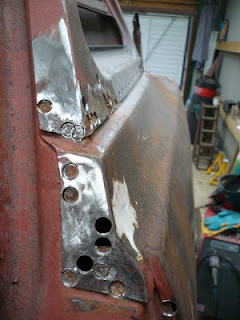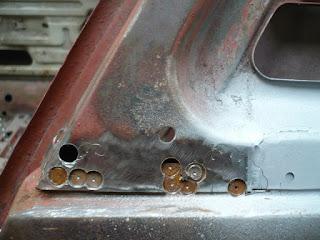Of the thousands of jobs available, I could never be a "p.a.", or "Executive Assistant" as they are now called. Last week I said I wouldn't be able to get in the garage for a couple of weeks, because I had other things going on in my diary. It turns out that I have my weeks wrong, so I am in fact here this weekend (clearly) and next weekend to boot. If I were a p.a., I would be a monumentally bad one.
Anyway, I did get in the garage for a while this weekend to start on what I thought would be a relatively easy job - the rear wing. It has to come off, I have decided, because (a) it has more dents than Romain Grosjean's Lotus and (b) I have a new one, waiting to go on.
 |
| New wing and lower rear sill panel. |
To me there are two kinds of repair. One involves making patches, filling holes and generally making it up as you go along in the hope that nobody will ever see them. The other type is the drilling out of old spot welds, removing the whole panel pretty much intact, putting on the new panel and welding it it. The latter is my favourite, because you are starting with parameters that you can deal with, like where the panel is supposed to go, which panels it mates with etc. In effect it is giant Airfix model kit. This rear wing should be like that, as in theory I have to cut out the welds, take off the wing, and put a new one back in the same place. "Simples" as the irritating stuffed creatures from the car insurance ad would say. So, on to drilling out spot welds.
 |
| Top of rear wing-to-"B"-post |
With a new Draper spot weld drill the original spot welds were cut out along the flange to the "B"-post, which is the bit the door closes on. It amazes me how randomly placed the spot welds are, this is probably due to the Speke (Liverpool, UK) factory having a cup of tea or change of shift between welds.
 |
| Rear wing-to-"B"-post |
As the spot weld cutter can skid around and sometimes not locate properly, I have my own technique which is effective but very long-winded. First, use a centre punch on the weld, then drill a guide hole with a 1.0mm drill bit, then drill out the weld with the cutter. Sounds ok but it takes ages due to the continual changing of drill bits.
I then moved on to the area below the
rear quarter panel (WKC64/5), which I had previously repaired but cunningly left drilled but unwelded at the point it reaches the top of the rear wing.
 |
| Top of rear wing to rear quarter panel |
Next stop was some work drilling out welds around the boot gutter channels.
 |
| Wing to boot flange. |
I got a little bored after this and starting poking around in the boot to see what attached to what in there, and as well as finding that there are welds in the most unlikely of places (all to be cut) I discovered some more panels that need replacing (boo!). One is part of the boot floor, but after looking at it for a good ten minutes and wondering what on earth I was going to do about it, I realised I had a repair panel in stock which I had kind of forgotten about (yay!). It is the area highlighted in red, below.
 |
| Boot floor area needing repair. |
So, that will need to come out, too...more spot weld cutting. Forgetting what I have in my shed during excited and frenzied ebay sessions is a common occurrence, with carburettors being the usual theme. I now have three sets on their manifolds. I also bid for and won a rear bulkhead trim panel in incorrect blue the other day - with a view to re-colouring it - forgetting that I already have one in correct black. Doh! I should know better, as I once won a LWB Ford Transit on ebay after a few glasses of wine...
Finally I had a good poke around the rear lower sill panel (WKC207) and discovered to my guilty joy and amazement that it was made almost entirely of fibreglass heaped on top of rusty holes. Guilty joy because it was actually me who had carried out this bodge nearly twenty years ago, and amazement because I had entirely forgotten about it.
 |
| Rear lower sill panel, made of fibreglass. |
The warm glow of satisfaction I got from doing this repair all those years ago came flooding back to me, and I am proud that for once in my life I am discovering my own previous bodges and not those of someone else. I am pretty sure this one would have lain there undetected for years, such was its splendour.
 |
| Apparently it should look something like this. |
So, once again my friends, one repair will lead to another. Yes, replacing the rear wing will be a "simple" job of cutting out the spot welds and putting a new one on. But I now have to work on the boot floor, plus fit new inner and outer lower rear sill panels. At the same time, as they are all sort of inter-related. I have a feeling this is going to be like the front end all over again, with weeks of trial fitting and a myriad of clamps. One things is for sure, this blog post is bound to split into subsections! Look out for "Rear Lower Sill Panel Repair, Part 6" and "Boot Floor Repair, Part 108" coming soon to this site.
Maybe I will become an "Executive Assistant" after all.










































